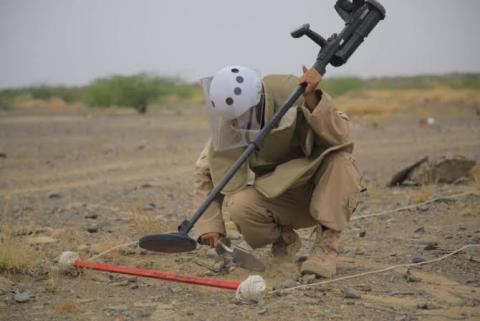Yemen’s Rabid Dogs Eat the Dead and Bite the Living, with Treatment Often Out of Reach


While cleaning a superficial gash with hydrogen peroxide, Dr. Ali tries to calm a distressed nine-year-old named Mason. Mason had just arrived at the al Jomhouri Hospital emergency room after being bitten by a dog while she was playing next to her home in Sana’a on Tuesday.
Al Jomhouri receives more than 60 patients a day with injuries from dogs, often rabid dogs. “There are large numbers of stray dogs in our neighborhood; one attacked my daughter [Mason] and bit her thigh,” recounts Essam Mohammed al-Shuja, Mason’s father. Rabies is a zoonotic viral infection of the central nervous system that causes encephalitis. The virus, if not quickly treated, has a near 100 percent fatality rate.
The number of people bitten by rabid dogs has increased noticeably since 2015 when the war on Yemen began. Most of the attacks are due to an increase in the population of feral dogs throughout Yemen’s cities and villages.
According to the Rabies Center in Sana’a, the only such center in Yemen, hundreds of people have been killed by the virus, and there were at least 14,000 confirmed rabies cases in 2018 alone. Yemen’s Ministry of Health said that in 2017 more than 10,000 people were infected with rabies, including over 3,000 people in Sana’a, resulting in at least 56 deaths.
Ahmed al-Ward, the director of the National Program for Rabies Control for the Ministry of Health, told MintPress News that over a thousand people have already contracted the deadly virus since the beginning of the year in Yemen’s capital city, Sana’a.
However, official infection and mortality rates in Yemen are likely to be highly inaccurate, as the country’s infrastructure lies in ruins following years of war. Furthermore, only a limited number of rabies victims in Yemen are able to reach hospitals, owing to rampant poverty and the danger that comes with traversing the country’s roads. Four years of near-constant airstrikes by Saudi Arabia and the United Arab Emirates have left Yemen’s roads impassable and have turned its hospitals and clinics to rubble.
Rabies was endemic in Yemen even before the Saudi-led war began. According to a 2013 study by the U.S. National Institutes of Health, out of the total number of animals involved in attacks on humans in Yemen, 63.3 percent tested positive for rabies. However, the number of people bitten by rabid dogs has increased significantly since 2015, when the war began.
Dogs and corpses
An official at the Fund for Hygiene said that the presence of large numbers of feral dogs and the lack of adequate food is driving the attacks on humans, especially children. But to Yemeni veterinary expert Ali Saad, what’s driving the dogs to attack is an acquired taste for human flesh.
“One of the most gruesome scenes you see after every massacre is hungry dogs roaming around a place to eat corpses or what remains of them,” Ali said. Packs of dogs often gather near the scene of bloody battles to feed on the dead bodies of the fighters and when the fighting subsides, they move to nearby villages and towns.
“I brought my mother here a month ago after she was bitten by a dog,” Khalid al-Alafi, who himself has rabies, said. “The dogs spread fear; we live in constant fear.”
According to a preliminary environmental study on hygiene and rabies conducted by Yemen’s Ministry of Health, there are about 70,000 feral dogs in the capital Sana’a and one million throughout greater Yemen. Most of them are suspected to have rabies.
Roaming packs of feral dogs, often especially active in the morning, have created a state of apprehension among families and children who used to walk in the early morning hours to school, prompting some families with no other means of transportation to keep their children home. Nearly 70 percent of Yemen’s dog-bite victims have been women and children; and half of those victims were under the age of 15, according to the National Program to Combat Rabies.
Some local officials, supported by residents, have a launched a campaign to exterminate thousands of feral dogs from the city’s streets. “Five field teams to combat stray dogs have managed to exterminate 11,000 dogs in the streets of Sana’a over the past two months,” Jamal Jahish, the director of the hygiene project in Sana’a, said.
This effort is a start, but will likely do little to address the larger causes of the rabies epidemics, which is being exacerbated by a crippling economic siege by the Saudi-led Coalition, a near-total collapse of Yemen’s health system, as well as the years of accumulated waste that have come to fill Yemen’s streets since the war began. The presence of food waste was found to correlate significantly with an increased risk for human exposure to rabies.
AFP.

Yemeni officials on Monday condemned arrests and prosecutions by the Iran-backed Houthi militia directed against media, journalists and celebrities…

Yemen's warring parties are gearing up for new waves of conflict in 2023 amid a lack of decisive steps towards sustainable peace, adding to the suf…

The UAE will help to recruit doctors and deliver crucial supplies for hospitals in Yemen under a major healthcare drive. The Khalifa bin…